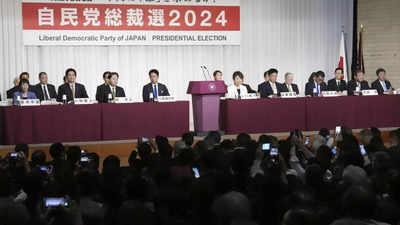
Japan's ruling
Liberal Democratic Party
(LDP) is set for a key vote this Friday to replace outgoing Prime Minister
Fumio Kishida
. A record nine candidates, including two women, are vying for the top job, with the winner almost certain to become Japan's next prime minister due to the LDP's dominance in parliament.
Earlier in August, Japan’s Prime Minister Fumio Kishida announced that he will be stepping down and not contest in the upcoming vote to elect a new chief for the ruling LDP.
Who are the key candidates?
Shigeru Ishiba
Ishiba has served as defence and agriculture minister, among other key roles. Known for his expertise in defence and security, he has advocated for a stronger Japan-US alliance and an Asian Nato. Ishiba supports progressive reforms like legalizing same-sex marriage and gender equality. Despite his popularity with voters, he has historically struggled to gain support from fellow lawmakers.
Shinjiro Koizumi
The son of former Prime Minister Junichiro Koizumi, Shinjiro is one of the youngest candidates. While his charm initially garnered wide support, his lack of policy depth has recently been scrutinized. Koizumi is known for his stance on flexible labor markets, gender equality, and climate change. He also regularly visits the controversial Yasukuni Shrine, which sparks regional tensions.
Sanae Takaichi
A conservative figure and protégé of former Prime Minister Shinzo Abe, Takaichi is vying to become Japan’s first female prime minister. She is known for her hardline views on national security, including bolstering cyber and space defense. However, her opposition to same-sex marriage and gender reforms, as well as her ties to controversial Abe faction members, has drawn criticism.
Other contenders
Other candidates include Yoshimasa Hayashi, a close ally of Prime Minister Kishida and former foreign minister known for his broad policy expertise, and Yoko Kamikawa, the current foreign minister, also aiming to become Japan's first female leader. Taro Kono, the digital minister, has shifted from opposing nuclear energy to supporting it in response to rising energy demands. Takayuki Kobayashi, a younger conservative figure and former economic security minister, and Toshimitsu Motegi, the LDP secretary general recognized for his negotiation skills, are also contenders. Katsunobu Kato, a former health minister and Abe ally, is focusing his campaign on economic growth policies.
Why is this vote important for Japan ?
Fumio Kishida's three-year term followed Yoshihide Suga's brief one-year stint, which ended due to widespread dissatisfaction with his handling of the Covid-19 pandemic. Regular leadership turnover in Japan has made it difficult for prime ministers to pursue long-term policy initiatives or build strong international relationships. However, Japan’s diplomatic and security policies are likely to remain anchored by its alliance with the United States.
While a prime minister with less factional influence can wield more personal power, maintaining stability will depend heavily on public approval ratings. The next leader will face the challenge of pushing through political reforms and managing escalating military, child care, and climate change costs, according to Yu Uchiyama, a political science professor at the University of Tokyo quoted by news agency AP.
A major scandal involving the failure of numerous influential party members to disclose political donations led to several indictments.
Election process
Voting is limited to LDP lawmakers and around 1.1 million party members. Due to the split field, a runoff between the top two candidates is likely. The dissolution of most of the LDP's influential factions means the winner will have to rely less on backroom deals and more on personal influence.
Political analysts warn that frequent changes in leadership could weaken Japan’s ability to address long-term issues and maintain stable international relations. Since 2000, Japan has seen several short-lived governments, with only Shinzo Abe providing sustained leadership for eight years. If the new leader cannot restore public confidence, Japan may return to a cycle of unstable governance.
When will Japan have a new prime minister?
On October 1, Prime Minister Kishida and his Cabinet will step down, with the new leader forming a fresh Cabinet after receiving parliamentary approval later the same day.
Although the current lower house term extends until October 2025, most candidates have signaled their intention to call an early election soon after taking office. Analysts anticipate an election within weeks, allowing the new prime minister to take advantage of a rejuvenated image.
The main opposition party, the Constitutional Democratic Party of Japan (CDPJ), has made some gains in local elections this year, largely due to scandals within the ruling Liberal Democratic Party (LDP). However, the CDPJ has struggled to maintain that momentum. On Monday, the CDPJ selected former Prime Minister
Yoshihiko Noda
as its new leader, marking a conservative shift aimed at appealing to swing voters and disillusioned LDP supporters.
( with input from agencies)












 English (US) ·
English (US) ·